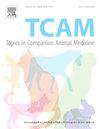Analgesic efficacy of pregabalin in dogs undergoing mastectomy with ovariohysterectomy
IF 1.3
3区 农林科学
Q2 VETERINARY SCIENCES
引用次数: 0
Abstract
The aim of this study was to evaluate the analgesic efficacy of pregabalin in dogs diagnosed with mammary carcinoma undergoing mastectomy with ovariohysterectomy. In a randomized, blinded, clinical, placebo-controlled study, 24 dogs were assigned to receive either an oral pregabalin suspension (4 mg/kg/0.1 mL/kg, Pregabalin group, n = 12) or a placebo solution (0.1 mL/kg, Placebo group, n = 12), administered 60 minutes before and every 8 hours after surgery. The dogs were premedicated with intramuscular (IM) morphine (0.3 mg/kg). Anesthesia was induced with intravenous (IV) propofol at a sufficient dose to allow intubation and was maintained with isoflurane. Intraoperatively, a constant rate infusion of morphine (0.1 mg/kg/h) was maintained until the end of surgery. Meloxicam (0.2 mg/kg, IV) was administered immediately after intubation. Intraoperatively, fentanyl (2.5 µg/kg, IV) was administered to control cardiovascular responses to surgical stimulation. Pain was assessed using the short-form Glasgow Composite Pain Scale 24 hours prior to surgery (baseline) and at 0.5, 1, 2, 4, 6, 8, 12, and 24 hours after extubation. Sedation scores were evaluated at the same time points using a descriptive numerical scale. Morphine (0.5 mg/kg, IM) was administered as rescue analgesia. Data were analyzed using t-tests, Fisher's exact test, Kaplan-Meier curve, Mann-Whitney test, and Friedman test. Differences were considered significant when P < 0.05. Pain scores, sedation scores, and analgesic requirements did not differ significantly between groups. Intraoperative fentanyl and postoperative rescue analgesia were required in 100% and 75% of the dogs, respectively, in both treatment groups. In conclusion, as part of a multimodal analgesic protocol, oral pregabalin at 4 mg/kg every 8 hours did not provide additional postoperative analgesic benefits over placebo in dogs undergoing mastectomy with ovariohysterectomy.
普瑞巴林在犬乳腺切除合并卵巢子宫切除术中的镇痛效果
本研究的目的是评估普瑞巴林对诊断为乳腺癌的犬行乳房切除并卵巢子宫切除术的镇痛效果。在一项随机、盲法、临床、安慰剂对照研究中,24只狗被分配接受口服普瑞巴林悬浮液(4mg /kg/0.1 mL/kg,普瑞巴林组,n = 12)或安慰剂溶液(0.1 mL/kg,安慰剂组,n = 12),术前60分钟和术后每8小时给予一次。预先肌注吗啡(0.3 mg/kg)。麻醉由静脉注射异丙酚诱导,剂量足以插管,异氟醚维持麻醉。术中持续等速输注吗啡(0.1 mg/kg/h)至手术结束。插管后立即给予美洛昔康0.2 mg/kg,静脉滴注。术中给予芬太尼(2.5µg/kg, IV)以控制对手术刺激的心血管反应。在手术前24小时(基线)和拔管后0.5、1、2、4、6、8、12和24小时,使用短形式格拉斯哥复合疼痛量表评估疼痛。在同一时间点使用描述性数值量表评估镇静评分。吗啡(0.5 mg/kg, IM)作为抢救性镇痛。数据分析采用t检验、Fisher精确检验、Kaplan-Meier曲线、Mann-Whitney检验和Friedman检验。P <;0.05. 疼痛评分、镇静评分和镇痛需求在组间无显著差异。两个治疗组中,术中使用芬太尼和术后使用抢救性镇痛的狗分别为100%和75%。综上所述,作为多模式镇痛方案的一部分,每8小时口服普瑞巴林4mg /kg并不比安慰剂提供更多的术后镇痛效果。
本文章由计算机程序翻译,如有差异,请以英文原文为准。
求助全文
约1分钟内获得全文
求助全文
来源期刊

Topics in companion animal medicine
农林科学-兽医学
CiteScore
2.30
自引率
0.00%
发文量
60
审稿时长
88 days
期刊介绍:
Published quarterly, Topics in Companion Animal Medicine is a peer-reviewed veterinary scientific journal dedicated to providing practitioners with the most recent advances in companion animal medicine. The journal publishes high quality original clinical research focusing on important topics in companion animal medicine.
 求助内容:
求助内容: 应助结果提醒方式:
应助结果提醒方式:


